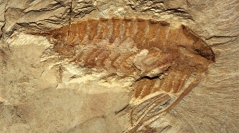

 Comptes Rendus Palevol
8 (2-3) - Pages 133-154
Comptes Rendus Palevol
8 (2-3) - Pages 133-154Marine ecosystems with complex trophic structure and dominated by animals started to build up in the Early Cambrian. Fossil evidence from exceptional fossil localities such as the Chengjiang Lagerstätte from South China indicate a high level of biological interactivity (e.g. prey–predator relationships) and the colonization of a wide range of pelagic and benthic niches by predators, scavengers, and detritus and suspension feeders. Swimmers are numerous, but there is no evidence for the extensive occupation of the water column by the Early Cambrian. On the contrary, animal life may have concentrated in hyperbenthic environments, close to the sea bottom. This would have been the initial step towards the colonization of the whole pelagic realm and the building-up of pelagic food chains. A chain of biotic innovations and events seems to have catalyzed both the animal diversification and the build-up of a completely new type of ecosytem, with: (1) the achievement of complex nervous systems, visual organs and motor functions; (2) the introduction of new selective pressure (e.g. predation and feed-back effects); and (3) the colonization of new niches. The role of environmental factors (e.g. oxygen, water chemistry, climate) may have been important in the early stages of metazoan evolution, but was probably negligible in the ecological turnover itself that takes place in the Early Cambrian. Close resemblances between the trophic structure of present-day ecosystems and that of Cambrian ones are confirmed by fossil data and recent mathematical models. This unprecedented increase of interdependence between animal species and trophic levels probably increased the general stability of marine ecosystems, but made them for the first time in their history, highly vulnerable to environmental perturbations. This will largely influence the post-Cambrian evolution of the marine world.
Cambrian, Ecosystem, Food chain, Trophic structure, Predation, Chengjiang, Burgess, South China, Canada